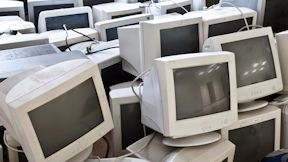|
|
Effectively Managing Remote Workers and Contractors

Thanks to improved technology, a growing number of employees have the ability to complete most or all of their work from home. Smart phones, tablet computers, teleconferencing, and WiFi-equipped bookstores and coffee shops have made this possible.
This presents a big advantage for employers: The more employees that work from home, the less money companies have to spend. Many companies, for example, don’t have assigned computers and desks for each of their workers because so much of their workforce is working remotely. At the same time, employees working remotely are often more productive; they’re not wasting time and energy commuting to work every day. And they’re not exchanging office gossip in front of the water cooler once they do arrive in the office.
Remote worker challenges
Remote workers and contractors do present at least one significant challenge to employers: It can be difficult for employers to effectively monitor the hours that their workers are putting in. How do employers know, after all, if their remote employees are pounding away at their keyboards or playing Angry Birds on their smart phones all day?
Employers can resolve this dilemma by setting reasonable deadlines for their remote employees and expecting these workers to meet them. What really should matter for employers is that work is done on time. It shouldn’t matter if workers complete their tasks from midnight to four in the morning.
Setting remote worker deadlines
Employers might tell their remote workers that they have must turn in a certain amount of work every Wednesday and Friday. This will make sure that remote employees are doing their work. Employers might also schedule regular updates by phone, video chat, or through instant messaging, during which workers can explain how far along they are with certain tasks.
Other employers prefer to require that their remote workers spend at least one day a week or two days a month onsite. This gives these workers face time with their managers, something that helps everyone stay focused on upcoming deadlines and goals.
Off-site not a permanent condition
Employers need to remember, too, that remote workers don’t have to stay that way. If employers discover that their off-site employees are not meeting deadlines or are turning in sub-par work, they can require that these workers return to the office on a full-time basis. Trust remains the key component of a remote working relationship. Employers must place some trust in their workers that they will complete their jobs on time. Workers must display that they are worthy of this trust by hitting their deadlines, turning in quality work, and responding quickly to phone calls or e-mail messages.
Top ↑
|
Staying Powered Up When Traveling for Business

There was a time when traveling for business meant losing touch with the home office. It was a struggle to receive e-mail messages, access important computer files, and schedule phone calls with important clients.
The good news is that staying powered up and connected to the office isn’t nearly the challenge it once was. You can put the credit for this on new technology.
Thanks to smart phones and some nifty cloud services, it’s easier than ever to stay connected to the home office.
Smart phones on the road
First, consider today’s smart phones. They allow you to pull up your e-mail messages no matter where you’re traveling. You can also compose and send messages to clients all through your smart phone. Most smart phones today also allow users to surf the Internet.
But what if you need to access an important file while on the road? The best way to do this is to plan ahead. You can, of course, e-mail important files to your own e-mail address. This way, when you need to access them, you can do so by scrolling through your e-mail files.
File-transferring software
That’s a bit cumbersome, though. A better choice is to download free software that allows you to drop your important files — everything from documents and presentations to photos and videos — into a sort of magic briefcase. After installing this software on your computing devices, laptops, desktops, smart phones and tablets, you’ll see a folder on your home screen. When you tap this folder, every file that you dropped into it, no matter from what computing device, will be available to you.
High-speed Internet access
Some of the better known of these services include the popular Dropbox and SugarSync apps. Both programs are easy to use and will make transferring files from one computing device to the next a simple task.
Once you’re at your destination, remaining in contact with your office should be easy. Most hotels today offer hi-speed Internet access and onsite business centers. Make sure before you travel, your destination hotel offers this service. If it does, you can easily connect to your e-mail and the Web while on the road.
Top ↑
|
Keep Your Important Data Safe with These Backup Options

Your computer’s hard drive is filled with important data – everything from new product reports to quarterly sales numbers.
However, what if your hard drive should crash? Is your critical data backed up? If not, you could lose it all.
Fortunately, there are plenty of options to easily store your important data. And surprisingly, a large number of them are easy to use.
The traditional way to back up data is to make copies of your reports and information on discs. You then store the discs in a safe place. This approach does work. The problem is that inserting disks and saving information on them is a bit of a hassle. A surprisingly high number of computer users forget to do this, or they decide to put it off. Then, when their hard drive crashes, their discs are empty and their data is lost.
Memory sticks are an alternative. These sticks, which you insert in your computer’s USB ports, come with varying amounts of storage. Instead of inserting a disc into your computer’s tower, you simply drag your important files to your memory stick, saving the data. The key, though, is to save your data as soon as possible. The longer you put it off, the more likely you are to forget to do it.
Another option growing in popularity these days is to save your data on the cloud with an online third-party storage service. Such services as Carbonite and Dropbox allow you to save your documents, reports, and images in a folder you create on your desktop. These documents are then automatically stored in the cloud, meaning that if your computer is damaged or your hard drive crashes, you can still log onto your storage service’s online home to retrieve your documents.
These services will also send your documents to any other equipped devices you own, such as your smart phone or tablet computer. You can then access your files with these mobile devices while you are on the go.
Of course, some trust is inherent in such services. You’ll have to entrust your data to a third-party source. However, for many users, third-party online storage is a quick and easy way to solve the data-backup problem.
Top ↑
|
Constant connectivity: When should you unplug?

Remember downtime? That’s when you could take your dog on a walk without having to answer your cell phone. It was, when you’d watch your child’s Little League baseball game without also scanning your e-mail messages with your smart phone. And it’s when you’d watch a movie at home without also working on your expense report on your tablet computer.
In this age of interconnectivity, downtime seems to be a thing of the past. The big question? Is this healthy?
It’s impossible to argue that our gadgets — our smart phones, tablets and high-speed laptops — haven’t made our lives easier. We can make restaurant reservations as we drive down the highway. If we’re lost, we can find directions on our smart phones. If we need advice on how to treat our children’s fevers, we can find medical advice by tapping the screen on our iPad.
However, all this connectivity does come with a price. We rarely have time to be alone with our thoughts. Some social commentators have wondered if our constant connectivity and the increased pressure to always be working — or playing — will cause the end of deep, philosophical thinking among humans.
That’s a big question, but there’s an even more important question for you to consider: Is your constant connectivity healthy? When should you unplug from your tablet, smart phone, and iPod?
It’s not healthy to always be working. It’s equally unhealthy to always be searching for the next piece of entertainment, gossip, or tweet from a friend. Simply put, the human body needs time to rest, to reflect, to think. If you find that you can’t go five minutes without checking your e-mail, sending a text, or Tweeting a friend, it might be time to unplug.
If you find, too, that your constant connectivity is harming your relationships with friends, family members, or your spouse, it’s time to turn off the computer and turn your smart phone on silent. It can be all too easy to plug in and turn off. After all, making real human conversation is a more difficult task than is surfing the Web or updating your Facebook page.
Of course, this debate isn’t new. How long have people fretted that television has sucked up too much of the attention of children and adults? It’s always the latest technology – and today that includes social media, tablets, laptops, and smart phones — that raise these fears.
If you find that you’re rarely without an electronic gadget in your hand, consider unplugging, at least for a short while. You might find that you’ve been missing an entire world, the real one.
Top ↑
|
A Bold Look at the History of the Computer

It’s difficult to imagine life without the computer. Today we carry miniature computers – that’s what smart phones are, after all – in our pockets. However, there was a time not too long ago when the majority of consumers didn’t have a single computer in their homes.
How did computers become such a key appliance in such a short amount of time? That’s the question that science historian and writer George Dyson asks, and answers, in his new book, Turing’s Cathedral, a sort of personal history of the computer.
Dyson has a unique vantage point that makes him the perfect author for this book. He’s the son of a top scientist, Freeman Dyson, and because of this spent much of his years at the Princeton Institute for Advanced Studies. The Institute was home to the globe’s most talented scientific minds – included Einstein’s – as they were in the middle of building and operating the first digital computers under the guidance of scientist Josh von Neumann.
After you’ve read Turing’s Cathedral, you’ll discover just how much chance went into creating the machine that led to the computers we now take for granted. The personalities at the Princeton Institute didn’t always mesh well, but somehow they managed to create the world’s first digital computer. This machine was assembled and run from an otherwise nondescript building in New Jersey.
Like all great projects, this one featured more than its share of rivalries, fall-outs, and, of course, salty language. The people behind this project were geniuses. They weren’t saints. The book also covers the important ethical issues the creators of the computer faced by the close relationship of their computer work to the U.S. nuclear weapons project.
You might think that a history of the computer would be a dry read. You might think that it’d be filled with impossible-to-understand jargon. Fortunately, Dyson’s history of the computer makes for a fascinating read, and you don’t need an advanced degree to understand it.
Anyone who uses a computer – and that’s an awful lot of people today, isn’t it? – should pick up a copy of Turing’s Cathedral. You might be surprised at what you learn.
Top ↑
|
|






Leave a Reply
Want to join the discussion?Feel free to contribute!